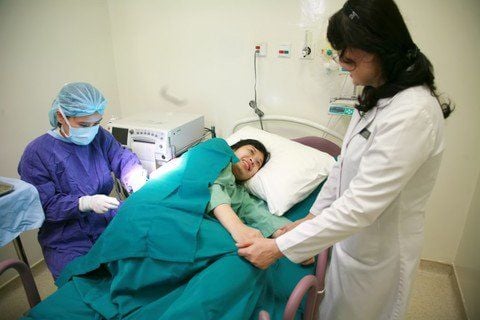This is an automatically translated article.
The article was professionally consulted by BSCK II Pham Thieu Trung - Department of General Surgery, Vinmec Phu Quoc International General Hospital.Reproductive function is a woman's vocation, in the process of giving birth, a woman must experience abdominal pain, folk often say "carrying heavy, giving birth"
Abdominal pain during labor is really not too much. dangerous to healthy pregnant women, but in cases of pregnant women with accompanying medical diseases such as: high blood pressure, diabetes, heart disease, lung disease, low pain threshold... a lot of pain will affect their health. health, psychology of the mother and to the health of the fetus, there are cases where the pain is too much for the mother to bear and sometimes requires the doctor to have a cesarean section, so the rate of cesarean section increases and the risks in Caesarean section will be available in these schools, instead of being able to relieve pain during childbirth
There are now many methods of pain relief during childbirth that are chosen by doctors including: Systemic pain relievers, causing pain relief. regional anesthesia, epidural anesthesia, spinal anesthesia, but now the epidural technique is the method chosen by many doctors because this method is the most effective. yes, safe.
1. Systemic pain relievers and side effects
Systemic pain relievers, most commonly used drugs of the opiate group (opioid group) have an analgesic effect. The drug is given as an injection into the body, by injection under the skin or intravenously (IV).
Many side effects include: Itching, nausea, vomiting, drowsiness and difficulty concentrating. Opioids are more likely to affect the breathing and heart rate of the mother after the injection and of the fetus after birth, the baby may be sleepy and this will make it more difficult to breastfeed the baby in the next few days. first hour after birth. Currently, very few people use this method due to many unwanted side effects for both the mother and the fetus.
2. Regional anesthesia
Regional anesthesia is pain relief by injecting local anesthetic into the area around the sensory nerves of a small area of the body, such as the vagina, vulva and perineum; to prevent pain just before birth. The drug is also used during an episiotomy or when sutured back tissues that have been damaged causing postpartum tearing...
Regional anesthesia rarely affects mother and baby, unless problems occur. problems related to a reaction or allergy to the anesthetic.
But this method of pain relief is not complete, because it does not relieve pain in the ligaments of the neck, body and fundus of the uterus and cervical dilation, so it is not an ideal method
3. Epidural Anesthesia

Gây tê ngoài màng cứng hiện nay là tiêu chuẩn vàng trong giảm đau trong chuyển dạ
Epidural anesthesia is now the gold standard for pain relief in labor. The method is to place a small tube (Catheter) into the maternal epidural space in the lumbar region, then put anesthetic through the Catheter into the epidural space continuously with an electric syringe during labor. Effective pain relief is very high, safe and does not affect the health of mother and fetus.
If during childbirth there is an indication for episiotomy, the woman will not feel pain completely provided that the doctor will give a little more anesthetic.
If for some special reason it is not possible to give birth naturally and requires a cesarean section (cesarean section), doctors will use local anesthetics through a Catheter with a higher dose of local anesthetic to use. pregnancy is painless. Convenient and safe.
Very rare side effects such as: allergy to anesthetics, back pain, low blood pressure
Currently, epidural anesthesia is used very popularly in the US and other countries with advanced medicine in the world. In the world, In Vietnam, there are many hospitals that have routinely applied this method.
4. Low-dose spinal anesthesia

Các phương pháp giảm đau khi sinh thường có rất ít tác dụng phụ và hiếm khi gặp rủi ro
Low-dose spinal anesthesia is used when the woman's cervix is almost fully dilated, the mother has severe abdominal pain but has not given birth. Spinal anesthesia is a low-dose drug injected into the spinal cord that provides quick pain relief, but the pain-relieving effect lasts for only one to two hours.
Undesirable effects for the mother, may appear less common side effects such as: numbness in the legs, decreased blood pressure, headache, back pain.
Please dial HOTLINE for more information or register for an appointment HERE. Download MyVinmec app to make appointments faster and to manage your bookings easily.
Articles refer to the source Acog.org












